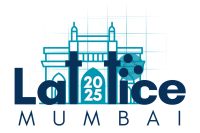Speaker
Description
A quantitative analysis of the universal aspects of QCD phase transition is required to achieve good control of the continuum as well as, infinite volume and chiral limits. In this talk, we will present a careful analysis of the latter two limits, taken at fixed values of lattice cut-off in the framework of (2+1)-flavor QCD. Although this does not yet allow to determine the universality class of the chiral phase transition of QCD, it provides a quantitative analysis of the chiral phase transition that appears in lattice QCD with staggered fermions.
We present results for the renormalized light quark chiral condensate, $M=M_\ell - H\,\chi_\ell$ , where $\chi_\ell$ is the light quark chiral susceptibility, obtained on lattices with temporal extent $N_\tau=8$ and spatial extent $N_\sigma$ varying in the range, $3 N_\tau < N_\sigma<10 N_\tau$ . Light quark masses $m_\ell$ expressed in units of the physical strange quark mass $m_s$ are varied in the range $1/240 \leq m_\ell/m_s \leq 1/27$. We compare results to finite volume scaling functions in the three dimensional O(2) universality class and quantify the contributions of the universal and non-universal parts to the chiral condensate.
| Parallel Session (for talks only) | QCD at nonzero temperature and density |
|---|

